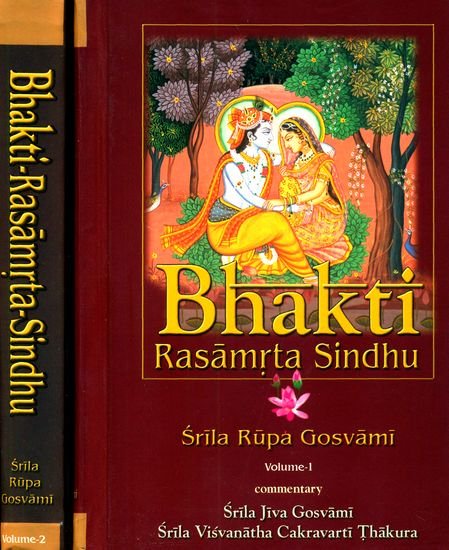Bhakti-rasamrta-sindhu
by Śrīla Rūpa Gosvāmī | 180,912 words
The English translation of the Sri Bhakti-rasamrta-sindhu verse 2.1.264; a medieval era Sanskrit book, written by Rupa Goswami (fl. 15th century) which represents a devotional (bhakti) masterpiece. In this work Goswami describes the nature and different forms of pure love (rasa) as well as various other topics on Vaishnavism and devotion.
Verse 2.1.264
Sanskrit text, Unicode transliteration and English translation:
यथा श्री-दशमे (१०.४३.१७) —
मल्लानाम् अशनिर् नॄणां नरवरः स्त्रीणां स्मरो मूर्तिमान्
गोपानां स्वजनो’सतां क्षितिर्भुजां शास्ता स्व-पित्रोः शिशुः ।
मृत्युर् भोज-पतेर् विराड् अविदुषां तत्त्वं परं योगिनां
वृष्णीनां परदेवतेति विदितो रङ्गः गतः साग्रजः ॥२.१.२६४॥yathā śrī-daśame (10.43.17) —
mallānām aśanir nṝṇāṃ naravaraḥ strīṇāṃ smaro mūrtimān
gopānāṃ svajano’satāṃ kṣitirbhujāṃ śāstā sva-pitroḥ śiśuḥ |
mṛtyur bhoja-pater virāḍ aviduṣāṃ tattvaṃ paraṃ yogināṃ
vṛṣṇīnāṃ paradevateti vidito raṅgaḥ gataḥ sāgrajaḥ ||2.1.264||
English translation
An example from the Tenth Canto of Śrīmad-Bhāgavatam [10.43.17]:
“The various groups of people in the arena regarded Kṛṣṇa in different ways when He entered it with His elder brother. The wrestlers saw Kṛṣṇa as a lightning bolt, the men of Mathurā as the best of males, the women as Cupid in person, the cowherd men as their relative, the impious rulers as a chastiser, His parents as their child, the King of the Bhojas as death, the unintelligent as the Supreme Lord's universal form, the yogīs as the Absolute Truth and the Vṛṣṇis as their supreme worshipable Deity.”
